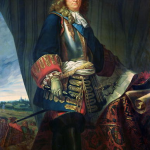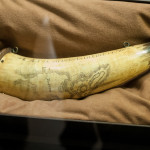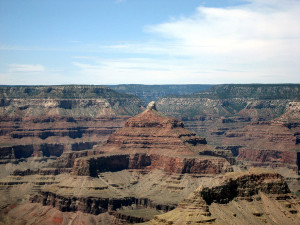I missed my regular Friday post because I was busy editing the first few pages of my new manuscript THIEF, now available in preview form on this very site. Take a look. And rest easy – your regular M-W-F publishing schedule will resume on Monday.
Monthly Archives: March 2013
The Sanctity of Reason
We have Freemasons in the family. Not my generation. (Um… not that I know.) But the light-blue apron I discovered in a dusty trunk decades ago is tangible proof that, once upon a time, my family was on the inside. We knew people. Also, presumably, stuff. Secret stuff.
Alas. I’ve yet to hear any revelations about the meaning of the eye in the pyramid or the current resting place of the Holy Grail. I haven’t received even a minute of coaching for any time-hallowed rituals. (Not unless that coaching was subtly concealed within episodes of ‘Hee Haw’ and ‘the Lawrence Welk show.’)
None of this stopped me from enjoying the first hundred pages or so of the loopy, shaggy-dog silliness of Robert Anton Wilson’s Illuminati books, wherein much is made of a purported connection between the Knights Templar, the Freemasons and the Founders of this country. (I finished the books. I just didn’t enjoy much past the first hundred pages. Ymmv. Also: Fnord.)
In an era when respect for the men and women who founded the United States borders on hagiography, I think it’s important to recognize that Washington, Jefferson, Franklin et al were a quirky and very human bunch. They weren’t saints. They had weird fascinations, flaws and obsessions, to be sure. But I tend to believe that the Freemasonry of the Founders’ era had more to do with giving people an excuse to socialize than anything more devious. People are awful at keeping secrets, and worse at working together amicably. I don’t doubt that conspiracies have been launched every few minutes throughout the whole of human history. I just struggle to believe many survive a single week, never mind many generations.
Oddly, no one in my family seems to know what happened to that trunk I opened, or the Masonic gear I examined. The house where I found the trunk was sold, and I’ve heard conflicting accounts of what happened with the contents. So-and-so thinks there was an auction. Another source reports that anything salvageable was donated to the Salvation Army and the rest thrown away. I’m certain that one of those two explanations is the right one.
Well. Almost certain, anyway.
Temples in the Desert
When my brother asked me what I knew about a location in the Grand Canyon off-limits even to park employees, he caught me by surprise. I’d never heard of any such. Only a little digging, though, unearthed another bit of fantastic Americana to rival the tunnels of the lizard people under Los Angeles. We’ve got tunnels again, but this time there’s also evidence of… ancient Egyptian culture?
“…(T)he archaeologists of the Smithsonian Institute, which is financing the expeditions, have made discoveries which almost conclusively prove that the race which inhabited this mysterious cavern, hewn in solid rock by human hands, was of oriental origin, possibly from Egypt, tracing back to Ramses.”
Hey, if you can’t trust an unsourced article (courtesy the April 5th, 1909 edition of the Arizona Gazette) who can you trust?
My natural skepticism prevents me from finding any of this very compelling. It’s Occam’s Razor again. Is it simpler to believe in a hundred-year old cover up of ancient Egyptian ruins in the Grand Canyon or that an unnamed reporter chose to spin a tale that would be difficult to verify, based upon a man the Smithsonian believes to be fictional?
The images from the Grand Canyon are plenty provocative for me, even if the Wikipedia article on Isis Temple isn’t sufficiently intrigued to mention anything other than a rational, science-based explanation for the formations. I’m not sure that’s entirely just. Any vision that survives so many decades must be touching people at some deep level.
It’s the kind of vision I’m happy to see enshrined in the deserts of Northern Arcadia.
(Lack of) Progress Report
I’ve marched out sixteen query letters. For fourteen of those, I’ve received either a rejection letter or I’ve waited a month without a reply. With only two outstanding query letters, and hope dwindling that getting WITCH published will be a relatively easy process, you might be wondering: what’s going to happen with Northern Arcadia?
I can’t quit, folks. I’m going to have the first draft for a second Northern Arcadia novel ready at the end of March, and I intend to publish the first fifteen or so pages of THIEF to this site. I’m going to continue to publish updates here every Monday, Wednesday and Friday, including posts on stuff I consider ‘fantastic America,’ behind the scenes detail on bringing this world to life and the odd post on the intersection of video games and the sort of character-driven narrative I favor.
IRL, I’m going to identify a couple, three writing conferences with a strong emphasis on imaginative fiction, and I’m going to attend with my smile up and my ears out. I want to get better at weaving stories where people can get cheerfully lost. Of course I’d like to be negotiating with a major publishing house right now. I’d love to have a high-powered agent with ties in the film and video game industries, and an editor with a merciless eye who isn’t afraid to tell me exactly what needs fixing.
But I’m not writing for fame, money, or other people’s approval. Not anymore. I’ve been guilty of all three in the past. These days, I write because I love writing. I write because when a passage or a page or a chapter works, I feel a sense of satisfaction that I get from nothing else.
A hundred rejection letters can’t take that away from me.
The Fabric of a New World: Outfits and Costumes
Gallery

This gallery contains 4 photos.
Costuming for a quasi-historical novel offers different challenges (and opportunities) for an author than a narrative set in a contemporary era. If I describe a guy with a silver beard, wearing Birkenstocks, jeans and a freshly-laundered tie-dye Grateful Dead t-shirt, … Continue reading
A Hundred Million Birds Fly Away
Image
I’ve followed REM since the Chronic Town EP (though, alas, not faithfully in recent decades.) After a weekend filled with personal sorrow, this track’s melancholy vocals, haunting guitar fills and stubbornly determined drum track suit my mood while also embodying the ‘alternative America’ feel I hope to pull off through the entire Northern Arcadia series.
Abigail and Lara
I’ve got a crush on a girl. It’s happened before, but we spent too much time together or got caught in a boring routine or something. The spark sputtered and went out. But… something’s different. We are. I’m older. She’s… younger? Yup, this is Lara Croft as I’ve never seen her (or the Tomb Raider video game franchise) before. She’s young. She’s vulnerable. She’s no longer cartoonishly top-heavy. (She even hates tombs!) The game follows her as she grows, hardens, and finds the mental focus that will allow her to be become the world’s most famous female artifact hunter.
The recent video game Far Cry 3 and this iteration of Tomb Raider have a good deal in common, including the island setting, the utility of the hero’s bow, and allusions to WWII-era Japan. Both games excel at creating an immersive on-screen world. Sneaking around in the tropics surrounded by hordes of armed opponents has never been so much fun!
But I doubt I’ll ever return to the world of Far Cry 3. That narrative for that game forces the player down a deeply unpleasant path (well, unless you happen to enjoy torturing family members) and at its conclusion provides players with a single choice with no gameplay ramifications: do you embrace being a bad guy or not?
How many people out there are going to choose the ‘I’m a bad guy’ option?
Thirty hours in, Tomb Raider has not hesitated to slop on the gore, but I haven’t been asked to use any enhanced interrogation techniques on my loved ones. I’ve watched as my character has faced challenges and in the aftermath evolved (in happy ways and otherwise.) Lara weeps, groans, and moans, but she perserveres.
Abigail Moore approves.
America and Americana
Idly flipping channels on a Saturday afternoon, I came across an awful sixties beach party movie. The camera lingered on the male lead, a young man whose profile seemed oddly familiar. The story wasn’t exactly new. The young man was pretending to be someone he was not, in order to win the heart of a lovely young lady. I didn’t know the name ‘Tommy Kirk’ until I did some quick reconaissance online. I knew his face. As a child actor, he’d featured in films like Old Yeller, the Shaggy Dog, Swiss Family Robinson. As a kid, I’d felt a connection to the boy I saw on-screen. I didn’t want to be him, I wanted to be his friend. His, ah, close friend. I wanted to inhabit his world, too, where everything was black and white, the Dads were all Fred MacMurray and adventures, even scary ones, invariably ended well.
Disney’s version of America was recommended to the grade school me and my classmates without caveat. Davy Crockett was the unquestioned king of the wild frontier, and Daniel Boone’s marksmanship, frontier savvy and natural genius deserved to be presented in no less than Walt Disney’s Wonderful World of Color.
Of course, even when very young, I understood there was an element of make-believe to Disney’s vision. I knew the world and other kids could be nasty; I had siblings. But Disney’s vision of a world living in harmony was one to which we all could aspire, right?
Cut to 1996. I’d graduated college and the world wide web was just being built out. It would take another five years before the debut of Google search. I had time to do some soul-searching. I admitted (first to myself, then others) that I felt more attracted to guys than girls. I thought about the ways I’d deceived myself through the years, and I remembered ‘that kid from the black and white Disney films, what was his name?’ I remembered wanting to be his friend. His close friend. I’d had a crush on the guy, I realized. I briefly felt mortified by my moony-eyed sixth-grade self but I moved on and I forget all about… what was his name?
A few years ago, I came across a ‘where are they now?’ photo spread, featuring Disney stars past and present. I learned that Tommy Kirk hadn’t quit movie-making to become a Fred MacMurray-style father. He’d been fired by Walt himself when the studio discovered Tommy Kirk was gay.
Look, Walt Disney’s accomplishments are staggering. Every man and woman of every era has flaws, and the sins of most eras are obvious only in hindsight. I don’t hate Disney for his bias against Tommy Kirk (and, by extension, me.)
But in Northern Arcadia, there will be room for “fresh faced, slightly goofy” young men who just happen to be attracted to other young men. There will be room for heroes who are women, and there will be room for people with skin in all shades of black, brown and tan.
That’s my idea of a truly ‘wonderful world of color.’
Into the Dark and Out into Light
Link
“The new Tomb Raider, after all, is a departure from earlier games; we see Lara like we never have before. She’s hurt, she’s bruised, she’s vulnerable—and none of that stops her.”
Scrimshaw Selection
Gallery

This gallery contains 6 photos.
I did a good stretch of my teen years in Massachussetts and Rhode Island. When we read Moby Dick in high school, the notion of whaling wasn’t something exotic or distant. My school organized yearly trips to Provincetown. At the … Continue reading

